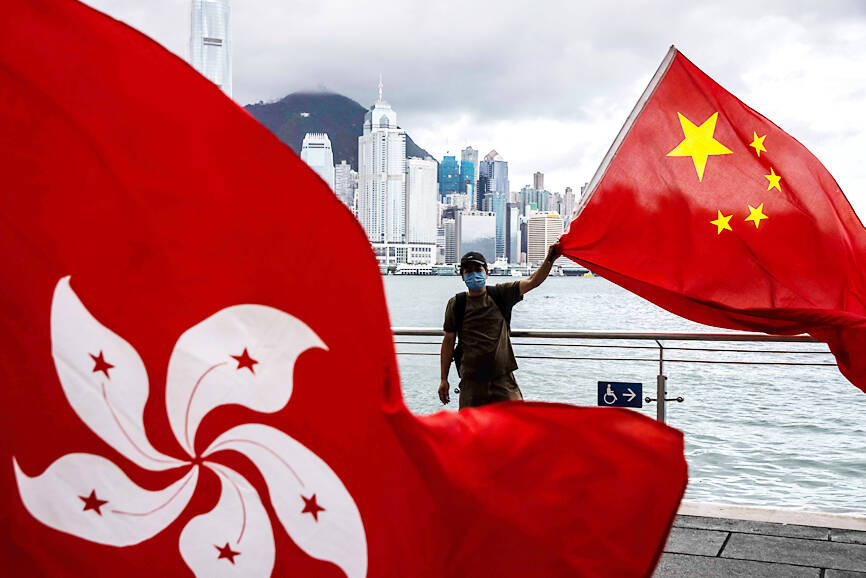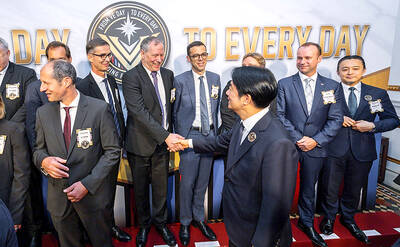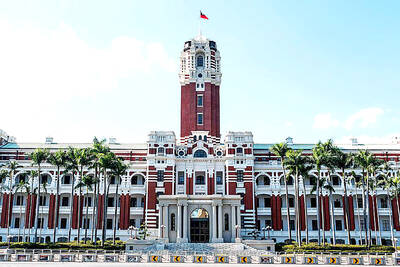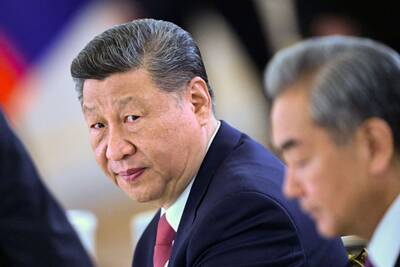A Hong Kong journalist group yesterday said that it was “very concerned” about the safety of an award-winning defense reporter who was reportedly missing after attending a security forum in Beijing.
Minnie Chan (陳敏莉), a reporter with the Hong Kong-based South China Morning Post specializing in defense and diplomacy issues in China, “became unreachable” after visiting Beijing to cover the Xiangshan Forum in late October, Japanese news agency Kyodo said, citing her friends.
The Hong Kong Journalists’ Association yesterday said that it was “very concerned about Minnie Chan’s safety and is asking South China Morning Post to learn more.”

Photo: AFP
It also urged relatives and friends to reach out with more information.
The South China Morning Post reported later yesterday that Chan “has taken personal leave” and that it was in contact with her family.
“Her family has informed us that she is in Beijing, but needs time to handle a private matter,” the newspaper said in an e-mailed statement. “Her family has told us she is safe, but has requested that we respect her privacy.”
Chan did not respond to a request for comment.
Asked about the Kyodo report, Chinese Ministry of Foreign Affairs spokesman Wang Wenbin (汪文斌) said he was “not aware” of the case.
The Hong Kong broadsheet’s Web site says that Chan’s most recent articles were from the Xiangshan Forum, which ended on Oct. 31.
She also wrote about the Chinese military’s overhaul and the abrupt sacking of Li Shangfu (李尚福) as Chinese minister of defense.

DEFENDING DEMOCRACY: Taiwan shares the same values as those that fought in WWII, and nations must unite to halt the expansion of a new authoritarian bloc, Lai said The government yesterday held a commemoration ceremony for Victory in Europe (V-E) Day, joining the rest of the world for the first time to mark the anniversary of the end of World War II in Europe. Taiwan honoring V-E Day signifies “our growing connections with the international community,” President William Lai (賴清德) said at a reception in Taipei on the 80th anniversary of V-E Day. One of the major lessons of World War II is that “authoritarianism and aggression lead only to slaughter, tragedy and greater inequality,” Lai said. Even more importantly, the war also taught people that “those who cherish peace cannot

STEADFAST FRIEND: The bills encourage increased Taiwan-US engagement and address China’s distortion of UN Resolution 2758 to isolate Taiwan internationally The Presidential Office yesterday thanked the US House of Representatives for unanimously passing two Taiwan-related bills highlighting its solid support for Taiwan’s democracy and global participation, and for deepening bilateral relations. One of the bills, the Taiwan Assurance Implementation Act, requires the US Department of State to periodically review its guidelines for engagement with Taiwan, and report to the US Congress on the guidelines and plans to lift self-imposed limitations on US-Taiwan engagement. The other bill is the Taiwan International Solidarity Act, which clarifies that UN Resolution 2758 does not address the issue of the representation of Taiwan or its people in

US Indo-Pacific Commander Admiral Samuel Paparo on Friday expressed concern over the rate at which China is diversifying its military exercises, the Financial Times (FT) reported on Saturday. “The rates of change on the depth and breadth of their exercises is the one non-linear effect that I’ve seen in the last year that wakes me up at night or keeps me up at night,” Paparo was quoted by FT as saying while attending the annual Sedona Forum at the McCain Institute in Arizona. Paparo also expressed concern over the speed with which China was expanding its military. While the US

‘FALLACY’: Xi’s assertions that Taiwan was given to the PRC after WWII confused right and wrong, and were contrary to the facts, the Ministry of Foreign Affairs said The Ministry of Foreign Affairs yesterday called Chinese President Xi Jinping’s (習近平) claim that China historically has sovereignty over Taiwan “deceptive” and “contrary to the facts.” In an article published on Wednesday in the Russian state-run Rossiyskaya Gazeta, Xi said that this year not only marks 80 years since the end of World War II and the founding of the UN, but also “Taiwan’s restoration to China.” “A series of instruments with legal effect under international law, including the Cairo Declaration and the Potsdam Declaration have affirmed China’s sovereignty over Taiwan,” Xi wrote. “The historical and legal fact” of these documents, as well